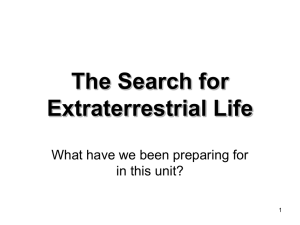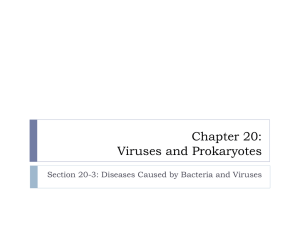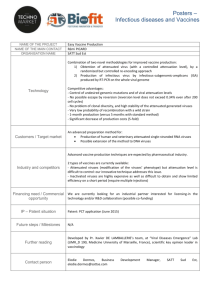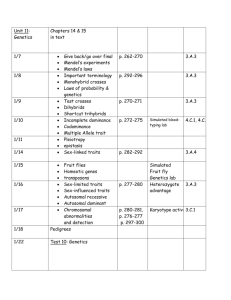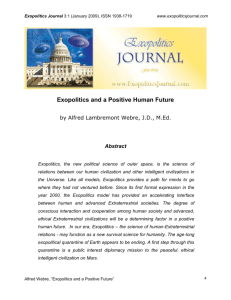local docx
advertisement
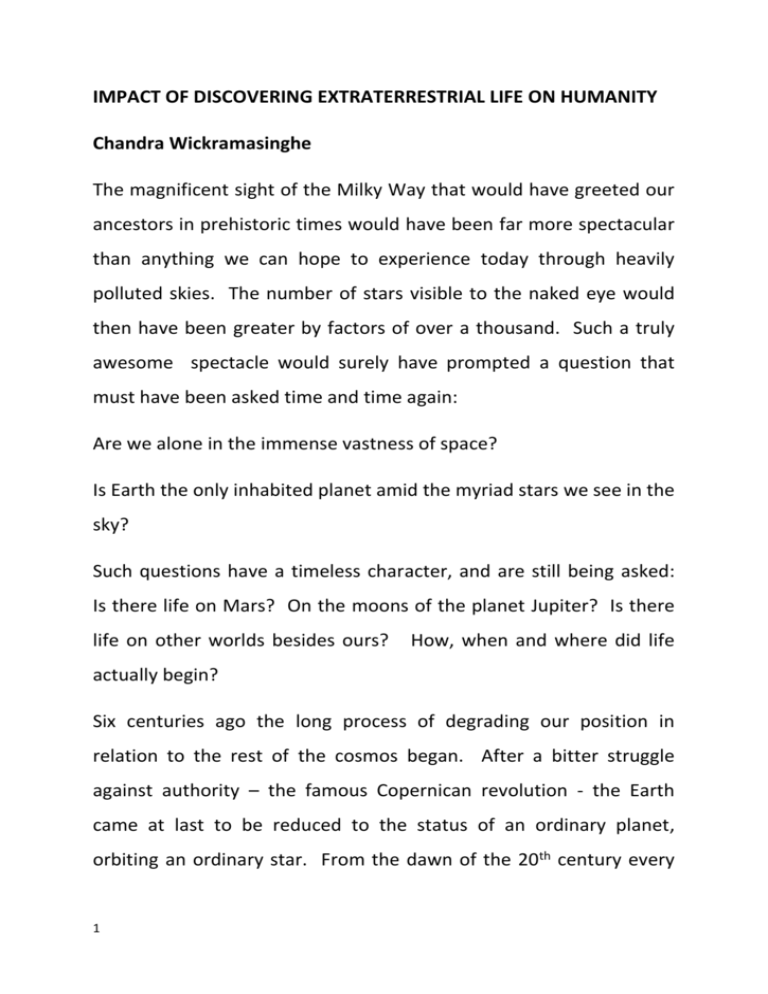
IMPACT OF DISCOVERING EXTRATERRESTRIAL LIFE ON HUMANITY Chandra Wickramasinghe The magnificent sight of the Milky Way that would have greeted our ancestors in prehistoric times would have been far more spectacular than anything we can hope to experience today through heavily polluted skies. The number of stars visible to the naked eye would then have been greater by factors of over a thousand. Such a truly awesome spectacle would surely have prompted a question that must have been asked time and time again: Are we alone in the immense vastness of space? Is Earth the only inhabited planet amid the myriad stars we see in the sky? Such questions have a timeless character, and are still being asked: Is there life on Mars? On the moons of the planet Jupiter? Is there life on other worlds besides ours? How, when and where did life actually begin? Six centuries ago the long process of degrading our position in relation to the rest of the cosmos began. After a bitter struggle against authority – the famous Copernican revolution - the Earth came at last to be reduced to the status of an ordinary planet, orbiting an ordinary star. From the dawn of the 20th century every 1 single discovery in astronomy has further diminished the position and importance of our planetary abode. The sun, at the centre of our solar system, is just one of a few hundred billion similar stars that make up the Milky Way; and the Milky Way itself is just one of hundreds of billions of similar galaxies that constitute the observable universe. Most astronomers believe that this entire universe was created as a result of a gigantic explosion – the Big Bang – that occurred 13.8 billion years ago. The question of extraterrestrial life can be discussed properly only against the backdrop of the immense vastness of the universe. In my view, we have for far too long regarded, without any proof whatsoever, that life must somehow be special to the Earth. Every textbook of biology starts by confidently asserting what is in fact only a scientific myth – the theory of the warm little pond on the Earth in which life is supposed to have begun. As soon as biochemists, in the 1950s and 1960s, had discovered the incredible complexity of even the simplest bacterium, which is of an astronomical order or even super-astronomical order, attention should have turned away from the idea of a small-scale terrestrial origin, to a process that encompassed the entire universe. The old primordial soup theory has little or nothing to commend it in the year 2013. Evidence from astronomy, geology and biology vigorously disputes its validity. 2 It is now over 40 years since I first proposed that life is a truly cosmic phenomenon, arising most probably, as a unique, albeit highly improbable singular event. Once started, however, life must spread inexorably to colonise every habitable niche in the cosmos. On this theory, life is all-pervasive and is carried everywhere in the form of cosmic dust – as freeze-dried bacteria and viruses. In our own immediate neighbourhood, we argue that life in the form of bacteria must have been first brought to the Earth by comets and meteorites almost 4 billion years ago. We argued also that a continuous supply of such bacterial and viral genes is imperatively needed in order to explain what is known about how life evolved on our planet from the simplest of microorganisms to the complex spectacle of life we see today. These ideas were resisted for a long time by mainstream science, that appears inextricably locked into a pre-Copernican mode of thought. New facts are now forcing a major paradigm shift from an Earth-centred biology to a cosmic-centred biology, in which life on our planet becomes a trivial expression of an all-pervasive spectacle of cosmic life. Recent advances in microbiology, including the discovery that many types of microbes can withstand the harshest imaginable environments, all point to a space origin of life. Microorganisms have been recovered from the abdomens of insects that were 3 trapped and fossilised in amber for over 30 million years. In a very recent study a deep frozen lake in Antarctica, sealed away from the outside world for over 15 million years, has yielded DNA evidence of life, including complex life, persisting under 4 kilometres of frozen ice. There is no Darwinian sense whatsoever by which these extreme survival attributes could have arisen in isolation on Earth. Only in the context of an open cosmic system, with an imperative need for surviving space travel, could all such properties be understood. My theory is in essence a modern rendering of an ancient idea – panspermia – first discussed by the Greek philosopher Anaxoragas in the 5th century BC. This theory embodies the concept that the seeds of life – microorganisms in our case - are present everywhere, and at all times in the Universe. I have already referred to the evidence from biology that favours this theory. Astronomical evidence for this point of view has also become so compelling in the past decade, that continuing to deny what now appears to be an obvious fact is fraught with imminent danger. We can now confidently assert that we have actually discovered the existence of extraterrestrial life in interstellar space and in the dust from comets, and even in a Sri Lankan meteorite that fell last year. One of the most exciting areas of modern astronomy is the search for planets that are similar to Earth orbiting distant stars. Many studies directed at such a search are presently under way deploying 4 the use of orbiting telescopes. The currently estimated tally of such Earth-like planets runs to over a hundred billion in our galaxy alone – averaging one “Earth” for every sun-like star. This means that the average separation between two Earth-like planets is a mere 4 light years. That is an incredibly short distance in cosmic terms and clearly shows that exchanges of bacteria and viruses between planets is not just possible, but is inevitable. The entire galaxy, our Milky Way system, can therefore be regarded as one single gigantic connected biosphere. It follows that life of all the types and forms known on Earth, ranging from bacteria to plants, animals and even intelligent life must, to a high degree of probability, be all-pervasive. On the 12th of February 2001 the code for the entire human genome was deciphered. One immediate surprise was that there were far fewer genes actually coding for proteins than we had thought – perhaps under 25,000. It is remarkably in sequences of nucleotides in our DNA that lies ouside the genes that the tangled web of human evolution is at last coming to be unravelled. A surprisingly large fraction of our DNA, perhaps as high as 50%, is in the form of viral sequences. And a subset of this is in the form of what we now recognise to be related to “retroviruses”, of a type of which the AIDS virus is just one example. Some years ago Hoyle and I were ridiculed for suggesting in the Lancet that the SARS and AIDS viruses may have originated in space. 5 From what is now emerging, however, it can be seen that this is most likely to be true. Our ancestral line, that led through primates and anthropoids to homo sapiens over hundreds of millions of years, shows clearly the relics of repeated viral or retroviral attacks presumably similar to AIDS. At each such viral attack the evolving line was almost completely culled, leaving only a small surviving, immune breeding group to carry through with a relic form of this virus tucked away in its genome. Viral sequences so added, I believe, provide evolutionary potential that could lead to new genotypes and new species at one end of the scale, and to new traits and the capacity to express our genes in novel ways at the other. It is becoming clear that our entire existence on this planet is contingent on the continuing ingress of cosmic viruses, which we had hitherto thought were merely the vehicles for disastrous pandemics of disease. Their positive role in evolution is only just beginning to be revealed. Over the past decade there has been a gradual realisation that life must be a truly cosmic phenomenon; and many people who were antagonistic to this idea in the past are beginning to voice contrary opinions about what should be done to cope with the realisation that life exists outside the Earth. In Davos, Switzerland earlier this year, the world’s business leaders and politicians met to discuss global risks and challenges that would confront humanity in the next 10 6 years. One of the top 5 global “risks” to be identified was the discovery of extraterrestrial life. This discovery it is reckoned would profoundly influence the entire future of humankind. The prevalence of life of any kind outside our cosy Earth raises issues connected not only with science, but with psychology, sociology and even religion. To some religious groups the realisation that the site of our “creation” was located outside the Earth may cause conflicts with theology. Earth-centred theologies and philosophies may need to be revised. The discovery of intelligent life outside Earth, if that happens, poses the most serious problems of all, calling for fundamental revisions and readjustments of our perceptions about ourselves. Even the mere proof that such extraterrestrial intelligence exists will seriously erode our perceived position of unrivalled supremacy in the world. And if extraterrestrial intelligence is indeed found to be resident nearby, and contact thought imminent, the situation might become analogous to the fear that primitive tribes may have had regarding the prospect of encounters with more civilised conquerors. This leads me in conclusion to discuss a far more serious threat that relates explicitly to your learned profession. In the near future it will become clear that bacteria and viruses coming to the Earth from outside could sometimes pose serious threats of pandemic disease, not only to humans, but also to plants and animals. 7 This is connected with an idea I explored as early as 1979 - that most of the pandemics throughout history were driven from space with the arrival of new viruses and bacteria. With all the data that is currently available across a wide spectrum of disciplines, I believe there is an urgent need for the possibility of bacterial and viral ingress from space to be taken seriously. I cannot illustrate this better than by quoting from an article by Dr. Louis Wienstein in the New England Journal of Medicine of 6 May 1976 in which he reviews all the available data relating to the influenza pandemic of 1918/1919 that caused some 30 million deaths worldwide: “The influenza pandemic of 1918 occurred in three waves. The first appeared in the winter and spring of 1917-1918….. The lethal second wave, which started at Ford Devens in Ayer, Massachusetts, on September 12, 1918, involved almost the entire world over a very short time…..Its epidemiological behaviour was most unusual. Although person-to-person spread occurred in local areas, the disease appeared on the same day in widely separated parts of the world on the one hand, but, on the other, took days to weeks to spread relatively short distances. It was detected in Boston and Bombay on the same day, but took three weeks before it reached New York City, despite the fact that there was considerable travel between the two cities. It was present for the first time at Joliet in 8 the State of Illinois four weeks after it was detected in Chicago, the distance between those areas being only 38 miles……” With no air travel in 1918 simultaneous first strikes in Boston and Bombay is strong evidence of a component of the virus falling in from space. From what I have presented today I maintain that we cannot afford to ignore such evidence. Measures must be put in place to monitor the stratosphere for incoming potential pathogens. In the event of a threat being discovered, preventative measures such as the production of appropriate vaccines could be put in place. In this way it might be possible to avert the worst consequences of any future pandemic that could threaten us. 9
